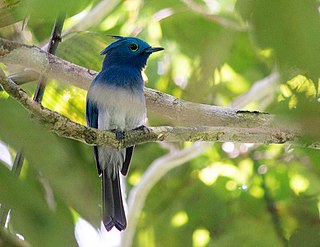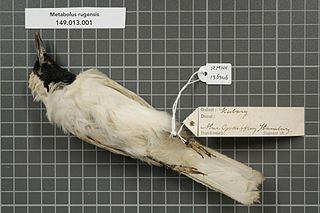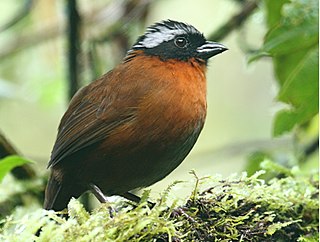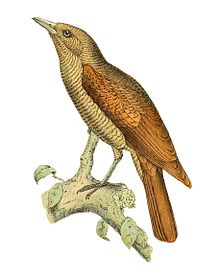
The International Union for Conservation of Nature (IUCN) Red List of Threatened Species, also known as the IUCN Red List or Red Data Book, founded in 1964, is an inventory of the global conservation status and extinction risk of biological species. A series of Regional Red Lists, which assess the risk of extinction to species within a political management unit, are also produced by countries and organizations.

Bernier's teal, also known as the Madagascar teal, is a species of duck in the genus Anas. It is endemic to Madagascar, where it is found only along the west coast. Part of the "grey teal" complex found throughout Australasia, it is most closely related to the Andaman teal.

The Luzon scops owl or the Luzon highland scops owl is a species of scops owl endemic to Luzon, Philippines. Not to be confused with the Philippine scops owl, sometimes referred to as the Luzon lowland scops owl, which is a more common species that shares the same range. The Luzon scops owl, however, is smaller and inhabits higher altitudes than its lowland relative.

The Madagascar serpent eagle is a species of bird of prey in the family Accipitridae. It is placed in the monotypic genus Eutriorchis. It is endemic to Madagascar. Its natural habitat is subtropical or tropical moist lowland forests. It is threatened by habitat loss.

The Mindoro hornbill is a species of hornbill in the family Bucerotidae. It is endemic to forests on Mindoro in the Philippines found in tropical moist lowland forests. As is the case with all Philippine tarictic hornbills, it was once considered a subspecies of P. panini. It is the only tarictic hornbill where both sexes are creamy-white and black. The sexes are very similar, differing primarily in the colour of the ocular ring. It is threatened by habitat loss, and is consequently considered endangered by the IUCN.

The golden-plumed parakeet is a Neotropical parrot species within the family Psittacidae, belonging to the monotypic genus Leptosittaca. This somewhat Aratinga-like species is found in humid temperate highland forests, especially with Podocarpus, on the east Andean slope in Colombia, Ecuador, and Peru. It is generally local and uncommon. It is threatened by habitat loss. Clearing of high-altitude forests for agricultural reasons have greatly impacted the loss of habitat for this parakeet species. Further reduction of such habitats will continue to diminish the number of golden-plumed parakeets left in South America. It is the only known parakeet species that can detect ultraviolet radiation.

The Malagasy sacred ibis is a relatively large, heavily built ibis endemic to the west coast of Madagascar, and Aldabra on the Seychelles.

The blue-headed quail dove, or blue-headed partridge-dove, is a species of bird in the pigeon and dove family Columbidae. It is monotypic within the subfamily Starnoenadinae and genus Starnoenas.

The Sakalava rail is a species of bird in the family Rallidae. It is endemic to western Madagascar. This bird is small with brown upperpart feathers, grey underparts, a yellow bill and red legs.

The forest thrush is a species of bird in the family Turdidae. It was historically the sole species within the genus Cichlherminia, however the AOU reclassified the species to the genus Turdus in 2009.
The flame-templed babbler is a species of bird of the family Zosteropidae, in the genus Dasycrotapha. It is one of the most remarkable and distinctive birds with its complex head markings with orange crown tufts, black ears and yellow beak and face. It is endemic to the Philippines, where it is found on the islands of Panay and Negros. Its natural habitat is tropical moist lowland forest. It is threatened by habitat loss. Along with the Negros striped babbler, it is one of the two babbler species extremely sought after by birdwatchers on Negros.

The red-bellied grackle is a species of bird in the family Icteridae. Its genus, Hypopyrrhus, is monotypic.

The celestial monarch is a species of bird in the family Monarchidae, and one of the most attractive of all the monarch flycatchers, with its spectacular blue crest and large greenish-yellow wattle. It is endemic to the Philippines with its extant range being in Luzon, Samar, Mindanao Tawi-Tawi and Basilan and it being possibly extinct on Negros and Sibuyan Island. It is often observed in mixed flocks with other birds such as blue fantails, rusty-crowned babblers, rufous paradise flycatchers, both short-crested monarchs and black-naped monarchs and other small forest birds. Its natural habitat is tropical moist lowland forests up to 750 masl. It is one of the most sought after birds by birdwatchers in the Philippines and in the world.

The Chuuk monarch, or Truk monarch, is a species of bird in the family Monarchidae. It is monotypic within the genus Metabolus. It is endemic to the island of Chuuk in Micronesia.

The Jamaican blackbird is a species of bird in the New World blackbird and oriole family Icteridae. It is the only species (monotypic) in the genus Nesopsar. The species has sometimes been included in the genus Agelaius, but molecular systematics have shown it not be closely related to any living New World blackbird or grackle. The species is endemic to Jamaica, where it is restricted to Cockpit Country, some central areas and the Blue and John Crow Mountains.

The tanager finch is a songbird species. In spite of its common name, it is neither a tanager nor a finch, but a New World bunting, having been moved to that family after variously being placed in either the Emberizidae or the true tanager family Thraupidae. It is the only species in the monotypic genus Oreothraupis. It is found in Colombia and Ecuador, where its natural habitat is subtropical or tropical moist montane forests. It is threatened by habitat loss.

Grauer's broadbill, also known as the African green broadbill, is a species of bird in the family Eurylaimidae, and is monotypic within the genus Pseudocalyptomena. Its name commemorates the German zoologist Rudolf Grauer who collected natural history specimens in the Belgian Congo.

The white-breasted thrasher, also known as goj blan in Creole, is a species of bird in the family Mimidae. Semper and Sclater (1872) describe the white-breasted thrasher as an "inquisitive and noisy bird" that would often "keep up a constant warning chatter, and throw itself about in all sorts of contortions" when being disturbed. It is endemic to Martinique and Saint Lucia, found only on these two islands of the Lesser Antilles. This resident species is easy to find within its range; however, it is classified as endangered by the IUCN Red List of Threatened Species mainly due to its restricted habitat.

The slender antbird is an endangered species of bird in the family Thamnophilidae. It is monotypic within the genus Rhopornis. It is endemic to dry forest at altitudes of 100–1,000 metres (330–3,280 ft) in Bahia and Minas Gerais in Brazil. It is threatened by habitat loss. This relatively long-tailed antbird is about 19 centimetres (7.5 in) in length. Both sexes are grey with black-and-white markings on the wings and red eyes. The male has a black throat, while the female has a white throat and a brown crown.

Swynnerton's robin is a species of bird in the family Muscicapidae. It is monotypic within the genus Swynnertonia. The common and Latin names commemorate the entomologist Charles Swynnerton.




















